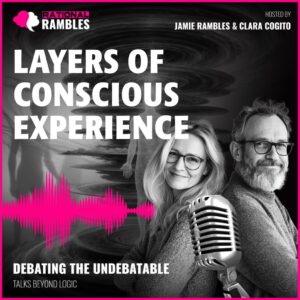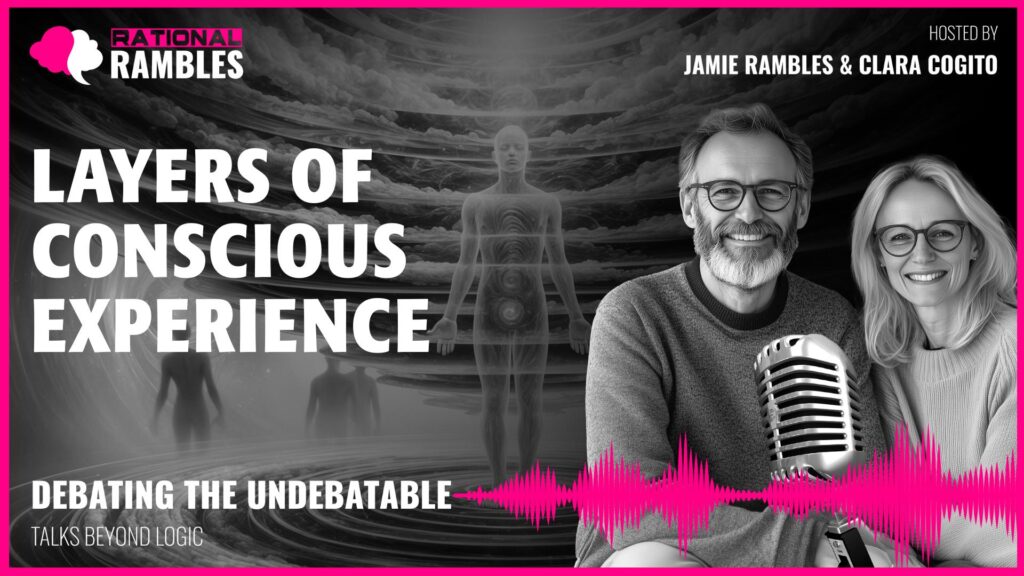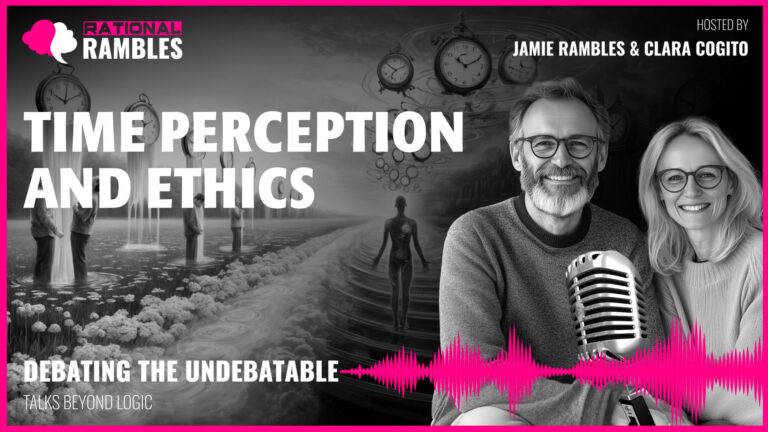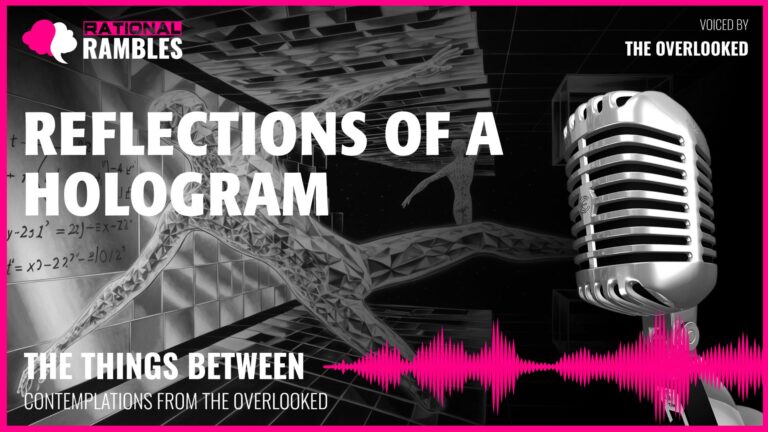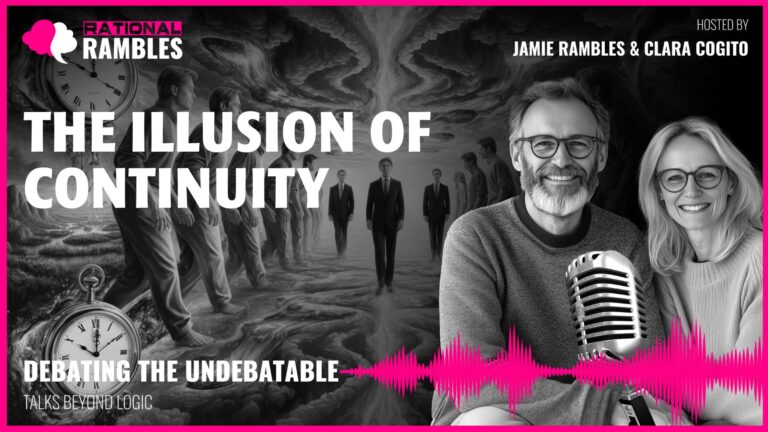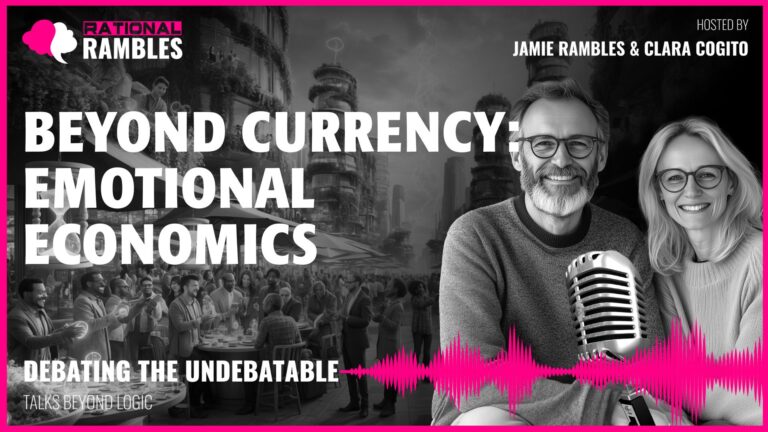Layers of Conscious Experience: Exploring the Stratification of Meta-Consciousness
Introduction: The Recursive Mirror of Awareness
What happens when consciousness turns inward and observes itself? And what occurs when that self-observing awareness further examines its own process of observation? This fascinating recursive property of human consciousness—the ability to not just experience but to know that we are experiencing, and to know that we know—opens up profound questions about the nature of mind and the possibilities for human experience.
The concept of meta-consciousness stratification invites us to consider consciousness not as a flat, singular phenomenon but as a potentially infinite series of recursive levels. Like mirrors facing each other, creating an endless corridor of reflections, our awareness can fold back upon itself repeatedly, potentially generating new qualitative dimensions of experience with each recursive turn. This exploration takes us to the frontiers of phenomenology, cognitive science, and contemplative wisdom, raising fundamental questions about the nature and limits of human consciousness.
As we venture into these depths, we must consider: Do these recursive layers of awareness merely add more of the same kind of consciousness, or do they generate qualitatively different forms of experience? At what point might this stratification transform our very sense of self and our relationship to experience? And would a consciousness capable of simultaneously maintaining awareness across multiple meta-levels still be recognizably human, or would it represent a fundamentally different kind of mind?
Understanding the Levels of Consciousness
To grasp the concept of meta-consciousness stratification, we must first establish a framework for distinguishing between different levels of awareness. At the most basic level, we find primary consciousness—the immediate awareness of perceptions, sensations, emotions, and thoughts. This first-order consciousness constitutes our direct experience of the world and ourselves.
First-Order Consciousness: The Primary Experience
This baseline level is simply the raw experience itself: seeing a sunset, feeling anxiety, hearing music. At this level, there is experience, but not necessarily any awareness of having that experience. Many non-human animals likely operate primarily at this level, experiencing the world without reflecting on their experiences.
Second-Order Consciousness: The Reflective Mind
At this level, we become aware of our own mental states. It’s the difference between merely feeling anxious and recognizing “I am feeling anxious.” This self-reflection represents a crucial cognitive leap, enabling us to observe and potentially regulate our experiences rather than simply being immersed in them. Most adult humans regularly operate at this level, which forms the basis for our self-awareness and introspective capabilities.
Third-Order Consciousness: Observing the Observer
Here, we become aware of our own process of reflection. Not just “I am feeling anxious” but “I notice that I am aware of my anxiety.” This meta-meta-awareness allows us to observe patterns in how we typically reflect on our experiences. Some meditation practices specifically cultivate this level, developing what Buddhism calls “meta-awareness” — the capacity to observe not just experiences but the process of observing experiences.
Fourth-Order and Beyond: The Recursive Ascent
Theoretically, this recursion could continue indefinitely: becoming aware of the patterns in how we observe our process of reflection, then observing those observations, and so on. While our cognitive architecture may impose practical limitations on how many levels we can explicitly maintain, the possibility raises intriguing questions about what might emerge at these higher meta-levels.
As cognitive scientist Douglas Hofstadter suggests in his work on “strange loops,” recursive systems can generate emergent properties not predictable from their basic operations. Similarly, these higher levels of meta-consciousness might not just add another layer of the same kind of awareness but could potentially transform the entire system of consciousness itself.
The Qualitative Transformation Hypothesis
A central question in understanding meta-consciousness stratification is whether higher meta-levels simply provide “more of the same” or generate qualitatively distinct forms of experience. Evidence from various domains suggests the latter possibility deserves serious consideration.
Developmental Parallels
Developmental psychology offers instructive parallels. When children develop theory of mind—effectively reaching second-order awareness by understanding that others have different thoughts than their own—it fundamentally transforms their cognitive world. This isn’t merely an addition of more thinking capacity but represents a qualitatively different kind of thinking that reorganizes their entire understanding of social reality.
Similarly, each new meta-level of consciousness might create not just more awareness but a different kind of awareness, reorganizing the entire field of experience. Just as learning to read transforms one’s relationship to symbols, learning to maintain awareness at higher meta-levels might transform one’s relationship to consciousness itself.
The Panoramic Perspective
As meta-levels increase, one possibility is the emergence of what we might call a panoramic awareness—a form of consciousness that can perceive patterns across all lower levels simultaneously. This would represent not just an incremental change but a qualitative shift, like the difference between viewing individual trees and seeing an entire forest from above.
To visualize this: imagine being able to simultaneously experience your immediate emotional reaction to something, your reflection on that reaction, your awareness of patterns in how you typically reflect, your recognition of how your personal history shapes those patterns, and your consciousness of how all these levels interact in real-time. This would constitute experiencing multiple dimensions of your own mind concurrently—a form of awareness quite distinct from our ordinary sequential attention.
The Threshold of Transformation
If these meta-levels do create qualitatively new forms of experience, we might ask whether there’s a specific threshold at which this transformation becomes especially significant. Some theoretical models suggest that level four—where one becomes aware of observing oneself observing oneself—might represent such a threshold.
At this fourth level, the recursive complexity potentially becomes sufficient to generate feedback loops that create novel properties. It’s reminiscent of what happens in complex systems when they reach certain thresholds of interconnection and begin exhibiting emergent behaviors not predictable from their components.
The fourth level might enable one to perceive the entire architecture of one’s consciousness simultaneously, rather than sequentially navigating between different perspectives. To use an analogy: level one is being inside a house, level two is looking at the house from outside, level three is viewing the house and its surroundings from a hill, and level four is seeing the entire neighborhood including the hill from an airplane. Each perspective encompasses all previous views plus something qualitatively new.
Meta-Consciousness and the Transformation of Self
Perhaps the most profound implication of meta-consciousness stratification concerns its potential to transform our very sense of self. Our ordinary experience of selfhood involves what philosophers distinguish as the “minimal self” of basic consciousness and the “narrative self” constructed through reflection and memory.
From Entity to Process
As meta-consciousness develops through multiple levels, our experience of selfhood might shift from an entity-based model to a process-based understanding. Rather than experiencing the self as a stable, persistent thing, one might increasingly recognize it as a dynamic, constantly constructed process—less a noun and more a verb.
This parallels insights from both contemporary cognitive science and contemplative traditions. From a scientific perspective, what we experience as a stable self involves constant construction and maintenance—it’s process-based already, though we typically experience it as a stable entity. At higher meta-levels, this illusion of stability might dissolve as one becomes aware of the constant flux underlying the appearance of continuity.
Boundaries and Non-Duality
A related transformation concerns the boundaries between self and world. Our conventional experience maintains relatively clear distinctions between self and other, subject and object. However, certain contemplative states described in traditions worldwide suggest that higher meta-levels of consciousness may involve a softening or even dissolution of these boundaries.
This connects to research on what neuroscientist Robin Carhart-Harris calls the “entropic brain” hypothesis, which suggests that certain altered states involve a temporary relaxation of the brain’s ordinary boundary-maintaining functions. What’s particularly relevant is that such states aren’t necessarily less organized but differently organized, potentially allowing more flexible and comprehensive perspectives on reality.
While psychedelic experiences may offer temporary glimpses of boundary dissolution through disruption of normal cognitive function, developed meta-consciousness might achieve similar insights through expansion of cognitive capacity while maintaining coherence and integration. The result could be a form of awareness that recognizes the interconnected, relational nature of selfhood without losing functional coherence.
Empirical Correlates of Self-Transformation
Empirical research provides tentative support for these possibilities. Studies on long-term meditation practitioners show altered activity in the default mode network—brain regions associated with self-referential processing. These changes correlate with practitioners’ reports of experiencing selfhood differently, often describing it in more process-based, interconnected terms.
For instance, a 2015 study by Josipovic found that advanced meditators could maintain awareness of both focused attention and open monitoring simultaneously, suggesting a capacity for maintaining multiple awareness modalities that novices found difficult to integrate. Similarly, a 2020 study by Lutz et al. demonstrated that experienced meditators showed distinct neural signatures during meta-awareness practices, particularly in prefrontal regions associated with metacognition.
Contemplative Traditions and Meta-Consciousness
While these ideas might seem primarily theoretical, various contemplative traditions have developed sophisticated methods for cultivating meta-consciousness, suggesting these states aren’t merely speculative but potentially accessible through specific practices.
Buddhist Perspectives on Meta-Awareness
Buddhist psychology offers particularly detailed analyses of meta-consciousness. The practice of vipassana or insight meditation explicitly cultivates meta-awareness—the capacity to observe experiences, the process of observing, and the patterns that emerge across observations.
In Tibetan Buddhist traditions, practices like Dzogchen describe “rigpa”—a non-dual awareness that recognizes the nature of mind itself. This state isn’t characterized as an infinite regression of observer levels but as a direct recognition of the ground or nature of awareness that undercuts the usual subject-object duality.
What’s particularly relevant is the developmental trajectory these traditions describe: practitioners typically begin with effortful metacognition, deliberately observing thoughts and sensations. With practice, this develops into more effortless meta-awareness, where the observing process itself becomes less deliberate and more spontaneous. Eventually, some traditions describe reaching a state where awareness recognizes its own nature directly—what might be considered accessing higher meta-levels not through adding more layers of observation but through recognizing the fundamental nature of consciousness itself.
Hindu and Taoist Approaches
In Advaita Vedanta, the concept of “witness consciousness” (sakshi) describes a form of awareness that observes all phenomena including thoughts and the sense of self without becoming identified with them. This perspective doesn’t merely add another layer of observation but shifts the entire relationship between awareness and its contents.
Taoist traditions offer a complementary perspective with the concept of wu-wei or “non-doing.” This suggests that the highest development isn’t endless metacognitive effort but a return to naturalness where complex awareness functions without deliberate striving. This parallels the idea that developed meta-consciousness might not feel like more complexity but like elegant simplicity that encompasses complexity effortlessly.
The Integration of Effort and Effortlessness
A common thread across these traditions is that developing meta-consciousness involves a progression from effortful metacognition to effortless meta-awareness. Initial practice requires deliberate attention to the processes of mind, but advanced stages involve a paradoxical effortlessness where multi-level awareness becomes natural rather than strained.
This progression resembles learning any complex skill: playing piano initially requires conscious attention to each finger movement, but mastery brings an integrated awareness where individual notes become automatic while a higher-order awareness encompasses the entire musical piece. Similarly, meta-consciousness might initially require deliberate reflection, but higher levels could integrate into a more unified experience that feels simpler and more immediate despite encompassing greater complexity.
The Neuropsychology of Meta-Consciousness
Moving beyond pure phenomenology, we can consider what cognitive science and neuroscience suggest about the mechanisms and possibilities of meta-consciousness stratification.
Hierarchical Predictive Processing
Contemporary theories of brain function offer intriguing parallels to the concept of meta-consciousness levels. The predictive processing framework, elaborated by researchers like Karl Friston and Andy Clark, suggests that the brain operates through hierarchical prediction models—each higher level making predictions about patterns at lower levels.
This hierarchical structure bears striking resemblance to the recursive levels of meta-consciousness. What we’re discussing could be understood as becoming aware of these hierarchical processes themselves—making the implicit architecture of consciousness explicit in experience. As higher-order patterns become accessible to awareness, they might enable new cognitive capabilities entirely.
Research by Stanislas Dehaene and others on “global neuronal workspace” models of consciousness suggests that consciousness involves the broadcasting of information across specialized brain systems. Higher meta-levels might represent more comprehensive integration of information across these systems, allowing patterns to be recognized that would otherwise remain implicit.
Cognitive Constraints and Possibilities
Cognitive load theory reminds us of the limitations in how many items we can simultaneously maintain in working memory—typically around seven plus or minus two. This suggests potential constraints on how many explicit levels of meta-consciousness we can effectively manage at once.
However, practice and expertise can circumvent some working memory limitations through chunking and automatization. Just as expert chess players perceive board configurations as meaningful patterns rather than individual pieces, developed meta-consciousness might perceive patterns across levels rather than maintaining each level separately, potentially transcending some of these cognitive constraints.
Neural Correlates of Meta-Awareness
Neuroimaging studies provide preliminary evidence about the neural basis of meta-awareness. Research on meditation practitioners shows distinct patterns of activity, particularly in prefrontal cortical regions associated with metacognition, and altered connectivity between the default mode network (involved in self-referential processing) and attention networks.
A 2019 study by Lutz et al. found that meta-awareness in meditation was associated with specific activation patterns in the rostrolateral prefrontal cortex—an area linked to high-level metacognition. Even more interestingly, advanced practitioners showed different patterns than novices, suggesting that developed meta-awareness may involve reorganization of these neural processes rather than simply intensifying them.
While current neuroscience can’t yet directly address the highest meta-levels we’ve discussed, these findings provide tentative support for the idea that meta-consciousness development involves not just quantitative changes in neural activity but qualitative reorganization of functional networks.
Meta-Flexibility: Beyond Simple Recursion
As we consider these higher levels of meta-consciousness, an important refinement emerges. Rather than conceptualizing metaconsciousness development as simply climbing ever higher through discrete levels of recursion, we might better understand it as developing what we could call “meta-flexibility”—the capacity to navigate fluidly across the entire spectrum of consciousness modes.
The Paradox of Advanced Meta-Consciousness
Somewhat paradoxically, the most advanced form of meta-consciousness might include the wisdom to temporarily suspend explicit meta-awareness when appropriate. This parallels the Zen concept of “beginner’s mind” or the Taoist notion of wu-wei—effortless action that comes from transcending self-consciousness rather than enhancing it.
Advanced meta-flexibility would involve not getting stuck at any particular level, but developing the freedom to engage appropriate levels of awareness as situations require—sometimes highly recursive and reflective, sometimes immediate and direct. This connects to research on flow states, where self-consciousness actually diminishes during optimal performance.
Context-Sensitive Awareness
From a psychological perspective, this aligns with theories of post-conventional cognition, where rigid structures give way to more fluid, context-sensitive understanding. The highest development wouldn’t be permanent residence in abstraction but the wisdom to know which mode of awareness best serves the moment.
Some situations benefit from immediate, immersed awareness with minimal self-reflection (like athletic performance or artistic creation). Others require explicit metacognition (like analyzing personal patterns or solving abstract problems). The most developed consciousness might be one that could move seamlessly between these modes rather than being fixed at either extreme.
Integration Rather Than Transcendence
This perspective suggests that meta-consciousness development isn’t about transcending primary experience but integrating multiple modes of awareness. The goal wouldn’t be to permanently inhabit some ultimate meta-level but to develop the capacity for appropriate engagement across all levels—from immediate experience to the highest meta-reflection.
This integration model aligns with what philosopher Ken Wilber calls the “transcend and include” pattern of development, where higher stages don’t eliminate lower ones but contextualize and incorporate them. The most developed consciousness wouldn’t leave behind direct experience in favor of abstract meta-awareness but would maintain access to the full spectrum while adding the wisdom to navigate between levels appropriately.
Practical Applications and Ethical Considerations
Moving beyond theoretical exploration, we can consider the practical implications of meta-consciousness development, including potential benefits, challenges, and ethical dimensions.
Potential Benefits
Developed meta-consciousness might offer several advantages:
Cognitive flexibility: The ability to see situations from multiple perspectives simultaneously could allow for more nuanced understanding of complex problems. Research on metacognition consistently shows that higher meta-awareness is associated with better problem-solving, particularly for ill-defined or complex challenges.
Emotional regulation: Greater awareness of one’s own psychological processes might enable more skillful responses to challenging situations. Studies on mindfulness and metacognitive therapies demonstrate that developing awareness of emotional processes correlates with improved emotional regulation.
Interpersonal understanding: The ability to recognize patterns in one’s own consciousness might translate to better understanding of others’ mental states. Research on theory of mind suggests that sophisticated metacognition correlates with enhanced empathic accuracy.
Reduced cognitive biases: Many cognitive biases operate implicitly; meta-awareness might help identify and mitigate these biases. Studies show that specific metacognitive training can reduce certain cognitive biases, though complete elimination appears unlikely.
Challenges and Pitfalls
However, meta-consciousness development isn’t without potential pitfalls:
Rumination risk: Excessive self-focus can become maladaptive. Psychological research links certain forms of self-focused attention to depression and anxiety. Some individuals who develop heightened introspective abilities may become trapped in unproductive thought patterns rather than gaining insight.
Analysis paralysis: Too much reflection might impede action. As philosopher Heidegger noted with his concepts of “presence-at-hand” versus “readiness-to-hand,” analyzing our tools sometimes makes them less useful in the moment.
Dissociation dangers: Extreme meta-awareness might potentially lead to dissociative experiences where one feels disconnected from direct experience. While mild and controlled forms might be valuable for perspective-taking, extreme dissociation can be psychologically harmful.
These challenges suggest that healthy meta-consciousness development would need to balance awareness with acceptance and action—observing one’s thoughts without becoming entangled in them, while maintaining the capacity for engaged response.
Ethical Dimensions
The ethical implications of meta-consciousness development depend largely on how it’s integrated with values and intentions:
Enhanced responsibility: Greater awareness potentially brings greater responsibility. If developed meta-consciousness allows more perspective and choice in one’s responses, it might reasonably entail greater ethical responsibility for those choices.
Values integration: Meta-awareness alone doesn’t determine ethical outcomes—it interacts with values, character, and context. This suggests the importance of developing meta-consciousness within ethical frameworks that guide its application.
Accessibility concerns: If meta-consciousness development offers significant benefits, questions arise about equitable access to methods for cultivating it. This parallels broader concerns about unequal access to education and other developmental resources.
These considerations highlight that meta-consciousness, like other forms of human development, has both promise and peril, with outcomes significantly shaped by the values and contexts in which it unfolds.
Cultivating Meta-Consciousness
If meta-consciousness represents a valuable human potential, how might it be developed? Various approaches offer possible pathways, with evidence suggesting that deliberate practices can effectively enhance metacognitive capabilities.
Contemplative Practices
Traditional contemplative practices offer systematic methods for developing meta-awareness:
Mindfulness meditation: Practices that cultivate non-judgmental awareness of present-moment experience have been extensively studied and shown to enhance various forms of metacognition. A 2018 meta-analysis by Dunning et al. found significant effects of mindfulness training on executive function and metacognition across 60 studies.
Self-inquiry practices: Traditions like Advaita Vedanta offer structured approaches to investigating the nature of self and awareness through systematic questioning processes.
Focused attention to open awareness progressions: Many traditions describe developmental sequences moving from concentrated attention to broader awareness states, potentially facilitating the development of meta-awareness.
Educational Approaches
Educational systems can foster metacognitive development:
Explicit metacognitive instruction: Teaching students not just subject content but strategies for monitoring and evaluating their own learning processes has shown positive effects on academic performance and transfer of learning.
Perspective-taking exercises: Activities that require adopting multiple viewpoints on complex issues can develop metacognitive flexibility.
Reflective practices: Structured reflection on learning processes and experiences can enhance metacognitive awareness, particularly when guided by frameworks that promote deeper analysis.
Technological Supports
Emerging technologies offer novel possibilities for metacognitive enhancement:
Biofeedback systems: Technologies that provide real-time feedback on physiological and neural states can help individuals develop greater awareness of previously implicit processes.
Virtual reality environments: Immersive simulations that allow perspective-shifting and embodiment of different viewpoints might facilitate metacognitive flexibility.
Artificial intelligence augmentation: AI systems designed to highlight patterns in one’s thinking or behavior could potentially enhance metacognitive awareness by making implicit patterns explicit.
Integrated Approaches
The most effective approaches likely combine elements from multiple domains:
Practice with feedback: Regular metacognitive practice combined with accurate feedback appears particularly effective for developing sophisticated meta-awareness.
Community and dialogue: Intersubjective practices involving articulation of one’s understanding to others and engaging with diverse perspectives may enhance metacognitive development beyond what individual practice alone can achieve.
Ethical frameworks: Embedding metacognitive development within ethical frameworks appears important for ensuring that enhanced awareness serves beneficial ends rather than merely making one more effective at pursuing potentially harmful goals.
Research suggests that these approaches can significantly enhance metacognitive capabilities, though the development of the highest meta-levels we’ve discussed remains more speculative. Nevertheless, the evidence for substantial metacognitive plasticity supports the possibility that human consciousness may indeed be capable of development beyond what most individuals currently experience.
Conclusion: Human Potential and the Frontiers of Consciousness
Our exploration of meta-consciousness stratification returns us to fundamental questions about the nature of human potential and the frontiers of consciousness. Rather than viewing meta-consciousness development as transcending humanity, we might better understand it as expressing human potential more fully—rare not because it’s foreign to human nature, but because the conditions for its development are seldom cultivated.
This perspective aligns with philosophical traditions from Aristotle’s eudaimonia to Buddhist conceptions of enlightenment, which view human fulfillment not as escaping our nature but as actualizing its inherent possibilities. The capacity for meta-flexibility—fluidly navigating across the spectrum of consciousness from immediate experience to sophisticated meta-awareness—may represent one such inherent potential.
The development of meta-consciousness offers intriguing possibilities for enhancing human thriving through greater cognitive flexibility, emotional wisdom, and interpersonal understanding. Yet it also presents challenges, requiring integration with ethical frameworks and careful attention to potential pitfalls like rumination or dissociation.
As we continue to explore the frontiers of consciousness, both through contemplative practices refined over millennia and through cutting-edge cognitive science, we may discover that consciousness harbors depths and capacities beyond what most of us ordinarily experience. The recursive mirror of awareness, turning back upon itself through multiple levels, may reveal not just new ways of knowing but new ways of being—expanding our understanding of what it means to be conscious and what it means to be human.
The stratification of meta-consciousness thus invites us not to transcend our humanity but to explore its furthest reaches—discovering in the structure of awareness itself the possibility for more integrated, flexible, and compassionate ways of experiencing ourselves and our world.
References and Further Reading
Carhart-Harris, R. L., et al. (2014). The entropic brain: A theory of conscious states informed by neuroimaging research with psychedelic drugs. Frontiers in Human Neuroscience, 8, 20.
Clark, A. (2013). Whatever next? Predictive brains, situated agents, and the future of cognitive science. Behavioral and Brain Sciences, 36(3), 181-204.
Dehaene, S., et al. (2017). What is consciousness, and could machines have it? Science, 358(6362), 486-492.
Dunning, D. L., et al. (2018). Research review: The effects of mindfulness‐based interventions on cognition and mental health in children and adolescents–a meta‐analysis of randomized controlled trials. Journal of Child Psychology and Psychiatry, 60(3), 244-258.
Hofstadter, D. R. (1979). Gödel, Escher, Bach: An eternal golden braid. Basic Books.
Josipovic, Z. (2014). Neural correlates of nondual awareness in meditation. Annals of the New York Academy of Sciences, 1307(1), 9-18.
Lutz, A., et al. (2020). Investigating the phenomenological matrix of mindfulness-related practices from a neurocognitive perspective. American Psychologist, 70(7), 632-658.
Schooler, J. W. (2002). Re-representing consciousness: Dissociations between experience and meta-consciousness. Trends in Cognitive Sciences, 6(8), 339-344.
Vago, D. R., & Silbersweig, D. A. (2012). Self-awareness, self-regulation, and self-transcendence (S-ART): A framework for understanding the neurobiological mechanisms of mindfulness. Frontiers in Human Neuroscience, 6, 296.


